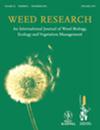杂草管理和耕作对墨西哥三种农业生态系统旱作玉米生产的影响
IF 2.2
3区 农林科学
Q2 AGRONOMY
引用次数: 1
摘要
玉米(Zea mays L.)在墨西哥广泛的农业生态环境和生产系统中种植。杂草是玉米产量的主要制约因素,但缺乏关于最佳杂草管理方法的知识。在许多生产系统中,减少耕作可以减轻土地退化和生产成本,但耕作的改变可能需要改变杂草管理。本研究于2016年和2017年在墨西哥瓦哈卡州3个农业生态不同地区,评估了5种杂草管理处理(出苗期前除草剂、出苗期后除草剂、出苗期前+出苗期除草剂、人工杂草控制和不控制)和3种耕作方式(常规耕作、最少耕作和零耕作)下的杂草动态和雨养玉米产量。在温带的Mixteca地区,杂草使玉米减产高达92%,生长季节较长,需要在苗期后进行杂草控制,从而显著提高产量。在炎热潮湿的Papaloapan地区,杂草使玉米产量降低了63%,苗期前杂草控制的产量显著高于苗期后杂草控制的产量。在半干旱的中部山谷地区,杂草使玉米产量减少了65%,但杂草管理在提高玉米产量或净盈利方面并不总是有效的。尽管免耕比免耕或常规耕作的杂草压力和潜在产量减少更大,但在每个地点,三种耕作制度下最有效的杂草管理处理趋于相似。没有发现跨场地或耕作系统的杂草管理的单一最佳选择。因此,需要进行更多的研究,其中不应忽视非化学方法,以确定最有效的杂草管理方法,适用于墨西哥各地不同的玉米生产系统。本文章由计算机程序翻译,如有差异,请以英文原文为准。
Weed management and tillage effect on rainfed maize production in three agro‐ecologies in Mexico
Maize ( Zea mays L.) is grown in a wide range of agro- ecological environments and production systems across Mexico. Weeds are a major constraint on maize grain yield, but knowledge regarding the best weed management methods is lacking. In many production systems, reducing tillage could lessen land degradation and production costs, but changes in tillage might require changes in weed management. This study evaluated weed dynamics and rainfed maize yield under five weed management treatments (pre- emergence herbicide, post- emergence herbicide, pre- emergence + post-emergence herbicide, manual weed control, and no control) and three tillage methods (conventional, minimum and zero tillage) in three agro- ecologically distinct regions of the state of Oaxaca, Mexico, in 2016 and 2017. In the temperate Mixteca region, weeds reduced maize grain yields by as much as 92% and the long- growing season required post- emergence weed control, which gave significantly higher yields. In the hot, humid Papaloapan region, weeds reduced maize yields up to 63% and pre-emergence weed control resulted in significantly higher yields than treatments with post- emergence control only. In the semi- arid Valles Centrales region, weeds reduced maize yields by as much as 65%, but weed management was not always effective in increasing maize yield or net profitability. The most effective weed management treatments tended to be similar for the three tillage systems at each site, although weed pressure and the potential yield reduction by weeds tended to be higher under zero tillage than minimum or conventional tillage. No single best option for weed management was found across sites or tillage systems. More research, in which non- chemical methods should not be overlooked, is thus needed to determine the most effective weed management methods for the diverse maize production systems across Mexico.
求助全文
通过发布文献求助,成功后即可免费获取论文全文。
去求助
来源期刊

Weed Research
农林科学-农艺学
CiteScore
4.30
自引率
0.00%
发文量
41
审稿时长
12-24 weeks
期刊介绍:
Weed Research is an international peer-reviewed journal that publishes topical and innovative papers on weed science, in the English language. Its aim is to publish the best weed science from around the globe and to be the journal of choice for weed science researchers. It is the official journal of the European Weed Research Society. Papers are taken on all aspects of weeds, defined as plants that impact adversely on economic, aesthetic or environmental aspects of any system. Topics include, amongst others, weed biology and control, herbicides, invasive plant species in all environments, population and spatial biology, modelling, genetics, biodiversity and parasitic plants. The journal welcomes submissions on work carried out in any part of the world.
 求助内容:
求助内容: 应助结果提醒方式:
应助结果提醒方式:


